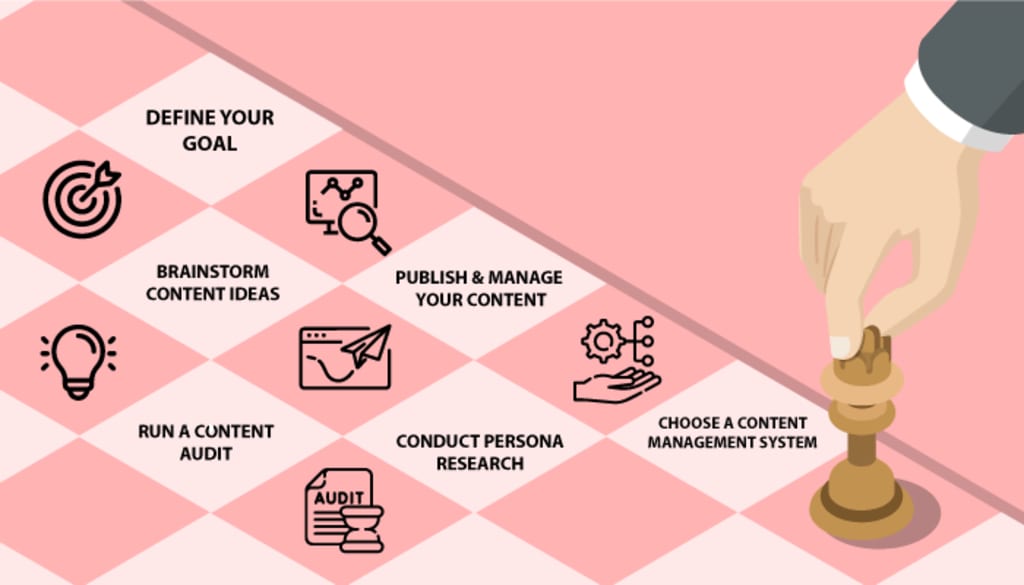How to Develop a Content Strategy in 7 Steps: A Start-to-Finish Guide
How to Develop a Content Strategy

If you're reading this, you likely already know that having a content strategy is important. After all, as Content Development Marketing Institute so eloquently put it, “Content is the atomic particle of all marketing.” But what exactly is a content strategy? And how do you develop one? In this post, we'll answer both of those questions and give you a step-by-step guide for developing your own content strategy. By the end, you'll have a clear plan for how to create and promote content that will help you achieve your business goals. Let's get started! Step:
1. Define Your Goal:-
The first step in developing a content strategy is to define your goal. What are you trying to accomplish with your content? Are you looking to generate leads, drive traffic to your website, or build brand awareness? Once you know what you want to achieve, you can start planning your strategy. If your goal is to generate leads, for example, you'll want to create content that is relevant to your target audience and that drives them to take action.
You might consider creating an ebook or whitepaper that addresses a pain point for your target audience, or offering a free trial of your product or service. If you're looking to drive traffic to your website, on the other hand, you'll want to create content that is SEO-friendly and that will rank high in search engine results. This might include blog posts, infographics, or helpful how-to guides.
2. Conduct Persona Research:-
When you’re first starting out with content strategy, it’s important to take the time to research your target audience. This will help you develop a more targeted and effective content strategy.
There are a few different ways you can go about conducting persona research. One way is to simply interview members of your target audience. You can also look at data sources like Google Analytics to see who is already engaging with your content. Once you have a good understanding of who your target audience is, you can start developing content that appeals to their specific needs and interests. This will help ensure that your content strategy is as effective as possible.
3. Run a Content Audit:
The first step in developing a content strategy is to run a content audit. This will help you take inventory of the existing content on your site, determine what's working and what's not, and develop a plan for moving forward.
To conduct a content audit, start by making a list of all the pages on your site. Then, go through each page and answer the following questions:
• What is the purpose of this page?
• Is the content on this page achieving its purpose?
• Is the content on this page engaging and relevant to its audience?
• Does this page have a call to action?
• Is this page easy to navigate and understand?
4. Choose a Content Management System:-
A content management system (CMS) is a platform that enables you to create, edit, publish, and manage your digital content in one central place. A CMS can make your content strategy more efficient and effective by giving you the tools to manage your content more efficiently and by providing a consistent publishing experience for your audience.
When choosing a CMS for your content strategy, there are a few key factors to consider:
•Ease of Use: Choose a platform that is easy for you and your team to use. The last thing you want is for your content strategy to be hindered by a complex or difficult-to-use CMS.
•Functionality: Make sure the CMS you choose has all the features and functionality you need to support your content strategy. Consider things like scalability, workflow management, integrations, and security.
•Cost: Don't break the bank when choosing a CMS. There are many great options available at different price points. Find one that fits within your budget.
•WordPress: WordPress is an open-source platform that powers millions of websites around the world. It's easy to use and comes with a wide range of plugins and themes to customize its look and feel. WordPress is also scalable, so it can grow with your business.
5. Determine which type of content you want to create
There are four different types of content that you can create:
•Informational: This type of content is designed to educate your audience about a particular topic. It can be in the form of a blog post, an article, a white paper, or even an e-book.
•Persuasive: This type of content is designed to convince your audience to take a particular action. It could be in the form of a sales letter, a case study, or even a video testimonial.
•Entertaining: This type of content is designed to entertain your audience and keep them engaged. It could be in the form of a funny blog post, an interesting video, or even a quiz.
•Interactive: This type of content is designed to get your audience involved and engaged. It could be in the form of a poll, a contest, or even a survey.
6. Brainstorm Content Ideas:-
Brainstorming content ideas can be a daunting task, but there are a few ways to make it easier. The first step is to come up with a list of topics you want to write about. This can be anything from your area of expertise, to current events, to pop culture.
Once you have your list of topics, it's time to start brainstorming ideas for individual pieces of content. You can try using a mind map or brainstorming web. These tools can help you visually organize your thoughts and come up with new ideas more easily.
7. Publish and Manage Your Content:-
Assuming you have a website or blog (if not, check out our guide on how to start a blog), it’s time to get started with some content! But before you start cranking out articles, you need a plan—a content strategy. A content strategy is basically a roadmap for your website or blog’s content.
It answers the question: what kind of content are we going to publish, and why? Creating a solid content strategy will save you time and money down the road, because it will keep you from publishing random pieces that don’t fit together or achieve your goals. So if you want your site to be successful, a good place to start is by developing a strong content strategy.
Conclusion:-
Developing a content strategy doesn't have to be complicated or time-consuming. By following these seven steps, you can create a content strategy that will help you achieve your business goals and connect with your audience. And, best of all, you can do it in just a few hours. So what are you waiting for? Get started today! k
About the Creator
Sprink Digital
Sprink Digital is a full-service online Digital Marketing Agency and primarily committed to the arena of Digital marketing exclusively.
Enjoyed the story? Support the Creator.
Subscribe for free to receive all their stories in your feed. You could also pledge your support or give them a one-off tip, letting them know you appreciate their work.






Comments
There are no comments for this story
Be the first to respond and start the conversation.